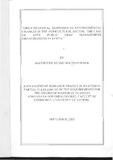| dc.description.abstract | Recent liberalization and globalization of world economies have caused
turbulence in the business environment. Hitherto protected organisations
have found themselves in unfamiliar trading environment. Their
operations, past inefficiencies and markets are no longer protected. They
are under pressure to re-align their management strategies and structures
to the changes in the environment.
This study sought to identify the factors causing turbulence in the Kenyan
public crop management organisations and document responses
formulated in both strategy and structure.
A census of the organisations was conducted and primary data obtained
through face-to-face interviews using a structured questionnaire. Data
was analysed using proportions, mean scores and percentages.
The study revealed that competition, price fluctuations, legislation, rising
costs of inputs and government divestiture were the major factors causing
impact in the public crop management organisations. It also revealed that
organisations undertook both strategic and operational responses to realign
themselves to the changes in the environment. Strategies
undertaken by most organisations included focussing on core business
and marketing, adapting new technology and private sector management
styles, product quality improvement and re-configuring internal
processes. Most organisations changed their structures to match the new
strategies. The resultant structures were more corporate goals driven,
more flatter, allowed more flexibility, more employee participation,
creativity and faster response to customer needs.
The study affirms Ansoffs strategic success hypothesis that a firm's
performance potential is optimum when the strategic behaviour matches
the environment turbulence and that the firm's capability matches the
aggressiveness of the strategy. The study however, does not explain how
the strategic responses were formulated. There is therefore need for
further research in this area. | en |

